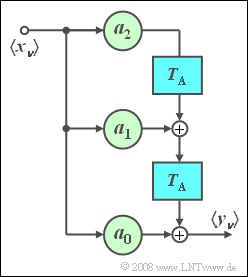Exercise 5.3Z: Non-Recursive Filter
Consider the adjacent non-recursive filter with the filter coefficients
- $$a_0 = 1,\quad a_1 = 2,\quad a_2 = 1.$$
We are looking for the respective output sequences $\left\langle \hspace{0.05cm}{y_\nu } \hspace{0.05cm}\right\rangle$ when the following value sequences are applied to the input:
- the "DC sequence":
- $$\left\langle \hspace{0.05cm}{x_\nu } \hspace{0.05cm}\right\rangle = \left\langle \hspace{0.05cm}{g_\nu } \right\rangle = \left\langle {\;1,\;1,\;1,\;1,\;1,\;1,\;1,\;1,\;\text{...} } \hspace{0.05cm} \right\rangle ,$$
- the "sinusoidal sequence" with period $T_0 = 4 \cdot T_{\rm A}$:
- $$\left\langle \hspace{0.05cm}{x_\nu } \hspace{0.05cm}\right\rangle = \left\langle \hspace{0.05cm}{s_\nu } \right\rangle = \left\langle {\;0,\;1,\;0, - 1,\;0,\;1,\;0, - 1,\;\text{...} } \hspace{0.05cm}\right\rangle .$$
Notes:
- The exercise belongs to the chapter Digital Filters in this book.
- Reference is also made to some chapters in the book Signal Representation.
- The HTML5/JavaScript applet "Digital Filters" illustrates the subject matter of this chapter.
Questions
Solution
- The maximum is at $T_{\rm A}$ ⇒ $\underline{\nu = 1}$.
(2) The frequency response $H(f)$ is the Fourier transform of the impulse response $h(t)$.
- The impulse response shifted to the left by $T_{\rm A}$,
- $$h\hspace{0.05cm}'(t) = \delta ( {t + T_{\rm A} } ) + 2 \cdot \delta ( t ) + \delta ( {t - T_{\rm A} } ),$$
- is symmetric at $t= 0$ and accordingly has the purely real frequency response
- $$H\hspace{0.05cm}'(f) = 2\big [ {1 + \cos ( {2{\rm{\pi }}fT_{\rm A} } )} \big ].$$
- By applying the shifting theorem, it further follows:
- $$H(f) = 2\big [ {1 + \cos ( {2{\rm{\pi }}fT_{\rm A} } )} \big ] \cdot {\rm{e}}^{ - {\rm{j}}2{\rm{\pi }}fT_{\rm A} } .$$
- Consequently, the value of the frequency response at frequency $f=0$ is
- $$H(f = 0)\hspace{0.15cm}\underline{ = 4}.$$
(3) The discrete-time convolution of the input sequence $\left\langle \hspace{0.05cm}{g_\nu } \hspace{0.05cm} \right\rangle$ with the impulse response $\left\langle \hspace{0.05cm}{h_\nu } \hspace{0.05cm}\right\rangle = \left\langle \hspace{0.05cm}{1, 2, 1 } \hspace{0.05cm}\right\rangle$ results in
- $$\left\langle \hspace{0.05cm}{y_\nu } \hspace{0.05cm}\right\rangle = \left\langle {\;1,\;3,\;4,\;4,\;4,\;4,\;4,\;4,\;4,\;4,\;4,\; \text{...} \;} \right\rangle $$
- In particular, $y_4\hspace{0.15cm}\underline{ = 4}$.
- With the exception of the values $y_0$ and $y_1$ (transient), we also obtain a synchronous sequence at the output with the constant value 4:
- $$y(t) = H( {f = 0} ) \cdot x( t ) = 4 \cdot 1 = 4.$$
(4) Analogous to subtask (3), we now obtain by shifting, weighting with $a_1$, $a_2$, $a_3$ and subsequent superposition:
- $$\left\langle \hspace{0.05cm}{y_\nu } \hspace{0.05cm}\right\rangle = \left\langle \hspace{0.05cm}{\;0,\;1,\;2,\;0,\; - 2,\;0,\;2,\;0,\; - 2,\;0,\;...\;}\hspace{0.05cm} \right\rangle .$$
- Thus, the value we are looking for is $y_4\hspace{0.15cm}\underline{ = -2}$.
Another solution:
- The input sequence $\left\langle \hspace{0.05cm}{s_\nu }\hspace{0.05cm} \right\rangle$ is sinusoidal with period $4 \cdot T_{\rm A}$. Accordingly, the basic frequency is $f_0 = 1/(4 \cdot T_{\rm A})$.
- At this frequency, the frequency response $H(f)$ has the following value according to subtask (2):
- $$H( {f = f_0 } ) = 2\big[ {1 + \cos ( {{{\rm{\pi }}}/{2}} )} \big] \cdot {\rm{e}}^{ - {\rm{j\pi /2}}} = 2 \cdot {\rm{e}}^{ - {\rm{j\pi /2}}} .$$
- Leaving the transient $($completed at $t = T_{\rm A})$ out of consideration, the following relationship between the input and the output signals is obtained with $\tau = T_{\rm A}$ $($phase: $90^\circ)$:
- $$y(t) = 2 \cdot x( {t - T_{\rm A} } ).$$
- That means: The sine function becomes the function "minus-cosine" with the amplitude 2.
